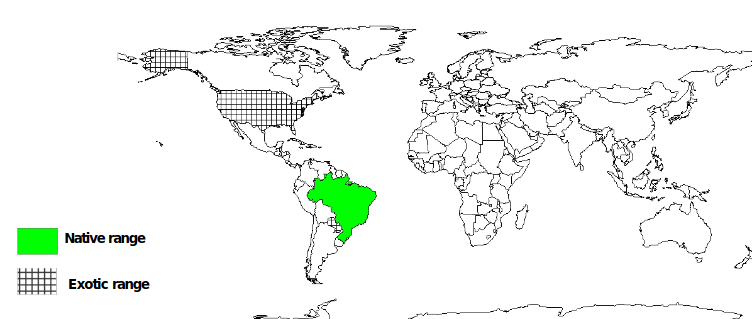Publication
from Agroforestree Database: a tree reference and selection guide
version 4.0
by C. Orwa, A. Mutua, R. Kindt, R. Jamnadass and S. Anthony
Eugenia
dombeyi (Sprengel)
Skeels
Local Names:
English (Brazil eugenia, Brazil cherry); French (jambosier du Bresil,
cerisier du Brésil, bois de nèfle); Portuguese (grumixameira,
grumixama); Spanish (grumichama)
Family:
Myrtaceae
Botanic
Description
Eugenia
dombeyi is a small, evergreen tree, 7-10(-20) m tall;
crown narrow, compact; trunk short with grey bark, branches suberect.
Leaves opposite, ovate to obovate-elliptic, 10-12 cm x 5-6 cm,
leathery, glossy, minutely pitted on both surfaces, margin recurved;
petiole 3-4 mm long; leaves persist for 2 years, buds large with
velvety scales, young shoots rosy.
Flowers solitary, axillary, 2.5 cm wide, white, slightly fragrant;
pedicle 3 cm; sepals 4, 8 mm long, green; petals 4, 15 mm long, white;
stamens about 100, white.
Fruit a globose to oblate berry, up to 3-5 cm in diameter, with
persistent sepals at apex, hanging on long, slender pedicel,
bright-red, dark purple to nearly black, or white, juicy, soft,
sweet. Seeds one to several, globose to angular, about 1 cm in
diameter, hard, light brown to grey-green.
Three varieties have been distinguished, based on little more than
fruit colour: var iocarpus
Berg (= var. dombeyi),
fruits deep violet; var erythrocarpus
Berg, fruit red; var. leucocarpus
Berg, fruits white, tallest trees, less common.
Biology
In the subtropics the trees flower synchronously in
spring. The fruit ripens within one month and the harvest is
over in a matter of days. In the tropics flowering and
fruiting extend over several months; in Rio de Janeiro the trees flower
from October to February.
Ecology
E. dombeyi
requires a humid, tropical to subtropical climate. Mature
trees tolerate frost to -3 deg. C for short periods, but young shoots
are affected.
Biophysical
Limits
Altitude: 0-90 m
Soil types: Deep sandy loams with good fertility, but acid rather than
calcareous, are preferred
Documented
Species Distribution
Native:
Brazil
Exotic: Cuba, Honduras, Mauritius, Paraguay, Puerto Rico,
US

The
map above shows countries where the species has been planted. It does
neither suggest that the species can be planted in every ecological
zone within that country, nor that the species can not be planted in
other countries than those depicted. Since some tree species are
invasive, you need to follow biosafety procedures that apply to your
planting site.
Products
Food:
The fruit of E. dombeyi
is appreciated more than that of several other, more widely grown Eugenia
species. The fruit has a thin and delicate skin, soft and
melting pulp and a mild subacid taste. The taste largely
resides in the skin. It is eaten fresh when ripe, or made into jams,
pies or preserves when half ripe. However, the persistent
sepals ('rabbit ears') and the modest flesh to seed ratio limit the
appeal of the fruit. Per 100 g edible portion, the fruit contains:
water 85 g, protein 0.6 g, fat 0.3 g, carbohydrates 13.4 g, fibre 0.6 g
and ash 0.4 g
Tannin or
dyestuff: The bark and leaves contain large amounts of
tannins, reportedly among highest found in plants (34% in the bark).
Essential oil: The
bark and leaves contain 1.5% of essential oil.
Medicine:
An infusion of 10 g of leaves or bark in 300 ml water is used as an
aromatic, astringent diuretic and as a treatment for rheumatism in
Brazil.
Services
Ornamental: Its dark, glossy leaves, reddish young shoots and shapely
canopy make the tree an attractive ornamental.
Tree
Management
Little or no pruning is required until the tree ages, as the canopy
remains compact. On light soils applications of organic matter as
manure or mulch are recommended. Light shade and protection
from strong winds are preferred.
Germplasm
Management
Seeds lose viability in about 6 weeks.
Pests and
Diseases
Diseases: Limb dieback caused by an unknown pathogen has been reported
from Florida.
Pests: The Mediterranean fruit fly can be a serious pest in Hawaii.
Further
Reading
Berg O. 1857. Myrtaceae. In: de Martius, C.F.P. (Editors): Flora
Brasiliensis 14(1). Leipzig. Pp. 347-348.
Campos Viana VR. 1977. Contribution to the study of wild fruits in the
vegetation of Rio de Janeiro. Leandra. 6-7(7): 95-106.
Fouqué A. (1972) Espèces Fruitières Dámérique Tropicale.
Fruits. 27(1): 62-72.
Maxwell LS, Maxwell BM. 1980. Florida fruit. Revised edition. L.S.
Maxwell, Tampa, Florida. P. 49.
Morton JF. 1987. Fruits of warm climates. Creative Resource Systems.
Winterville, N.C., USA. pp. 390-391.
Verheij EWM, Coronel RE (eds.). 1991. Plant Resources of South East
Asia No 2. Edible fruits and nuts. Backhuys Publishers, Leiden.
|
|
